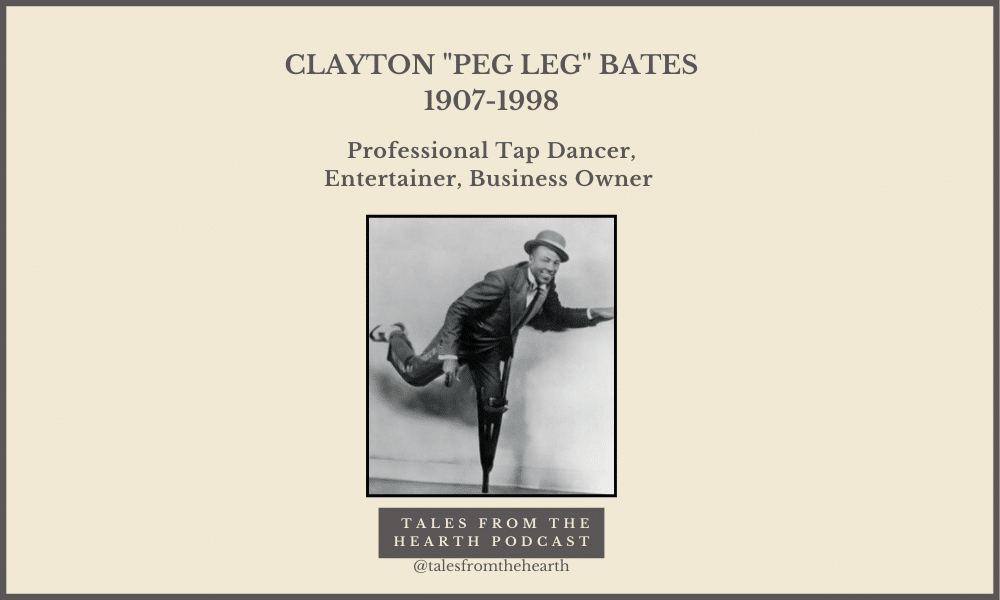Clayton “Peg Leg” Bates
October 11, 1907 – December 8, 1998
Episode Intro: Did you hear about a man who could dance better with one leg than many could with two? How about a man who appeared on the Ed Sullivan Show more than twenty times, and performed for Queen Elizabeth II of England—twice? Join us for today’s episode on the remarkable feats of South Carolinian Clayton “Peg Leg” Bates.
Let’s get cracklin’, shall we?
**********
I first heard about Clayton “Peg Leg” Bates from viewing his historical markers and statues in Greenville and nearby Fountain Inn, South Carolina. In downtown Greenville, the marker briefly relays Peg Leg Bates’ remarkable story of the tragic loss of his leg, followed by hard work and a successful international career in dancing. Peg Leg Bates lived a long life, dancing with the likes of Bill “Bojangles” Robinson, Gene Kelly, and Fred Astaire. I was astounded and amazed at how much Peg Leg Bates overcame to become such a success. I can’t wait to share his story with all of you today.
Sources for today’s story are: Many! As always, refer to the episode show notes at www.talesfromthehearth.com for links to all of the resources for today’s episode.
You can view many photos and links to information about Clayton “Peg Leg” Bates on our Pinterest board located at https://www.pinterest.com/TalesfromtheHearth/clayton-peg-leg-bates/
There’s a great children’s book entitled Knockin’ on Wood: Starring Peg Leg Bates by Lynne Barasch.
The One Takeaway I hope you get from this story is: Actually a quote from Clayton Peg Leg Bates himself, “You can do anything in this world if you want to do it bad enough.”
Now, I hope you enjoy the story about Clayton “Peg Leg” Bates.
**********
Clayton Bates was born on October 11, 1907, in Fountain Inn, South Carolina (just east of the city of Greenville). His father, Rufus Bates, was a sharecropper and laborer, and his mother, Emma Steward Bates, was also a sharecropper and housekeeper. As early as age five, Clayton started to perform and dance on downtown Fountain Inn streets for spare change.
At age twelve, Clayton was involved in a tragic accident with a conveyor at the cotton mill where he was working, requiring one leg to be amputated at the knee. Because hospitals were still segregated at this time, the operation was performed on his kitchen table. After returning from war a couple of years later, an uncle carved a wooden peg leg for him.
It didn’t take long for Clayton to get back to dancing: “It somehow grew in my mind that I wanted to be as good a dancer as any two-legged dancer. It hurt me that the boys pitied me. I was pretty popular before, and I still wanted to be popular. I told them not to feel sorry for me.”
Clayton began practicing and performing, tapping to the rhythm of tap dancers he had seen—adding his own flair for tumbling, stunts, and steps. He even ran away from home, working in minstrel shows, vaudeville, and other carnivals and festivals while learning to dance with his peg leg. Clayton landed his first job at the Liberty Theatre, located on Spring Street in Greenville, South Carolina. His big break came when the Dashing Diner Review played at the Liberty Theatre in 1924,(remove weird pause here) he set out on a national tour with the group at the age of fifteen. At this young age he became known as the champion of all uniped dancers—amazing everyone with his ability to quickly transition from athletic tumbling feats to a soft shoe tap—all in one performance.
Clayton “Peg Leg” Bates ended up in New York and decided to try his talents as a professional tap dancer. He landed a role in the Blackbirds of 1929 and was noticed by “Bojangles” Bill Robinson. Bojangles insisted on giving Clayton his first—and only—tap dancing lessons.
Bates went on tour to Paris with the Blackbirds of 1929 and returned to New York in 1930 to be a featured tap dancer in a plethora of Harlem’s clubs—such as the legendary Cotton Club and Club Zanzibar. Clayton continued on to Broadway, where he “shook up” and created special moves and cadences between the peg leg tone and the metallic tap.
His amazing skills and unique style allowed Clayton to break through the many prejudices and racial barriers of the time. Clayton toured and performed prolifically throughout the 1930s with interracial “big bands” and groups such as Jimmy Dorsey, Duke Ellington, Erskine Hawkins, Claude Hopkins, Louis Armstrong, Keith & Lowe, and Billy Eckstine (just to name a few). He appeared alongside (and sometimes received top billing with) Gene Kelly, Fred Astaire, and Bill “Bojangles” Robinson (who had given him tap lessons, remember?).
In 1948, Clayton Bates made his very first television appearance on This Is Show Business, featuring his signature acrobatic stunts, tapping and dancing on pointe as though he were a ballet dancer. As he put it, “Well, I’m into rhythm and I’m into novelty. I’m into doing things that look almost impossible to do.” The popularity of television, coupled with Peg Leg Bates’s incredible feats, propelled his career and star status across the nation.
Clayton was a busy, busy man! He was constantly performing in a variety of shows and venues—on television, Broadway, nightclub shows, demonstrations, theatres—you name it! Clayton stayed mostly in New York, until he performed for three years in a long-standing musical in Hollywood. It is unknown exactly when Clayton married his wife, Alice, but the pair had one child, a daughter named Melodye.
In 1951, Alice and Clayton renovated a farm in New York (located in the Catskill Mountains), into a resort called The Peg Leg Country Club. The interracial club focused on jazz and dancing entertainment, and the facility grew into the biggest of its kind in the nation to both serve—and be owned and operated by—African Americans. Big names and stars such as Ella Fitzgerald, Sammy Davis Jr., Sidney Poitier, Mel Tormé, Nat ‘King’ Cole, Duke Ellington, Billie Holiday, and Louis Armstrong found their way to the Peg Leg Country Club to perform. It was THE place to be in the Catskills in the summer.
Bates appeared more than twenty times on the Ed Sullivan Show, many of them in the form of dance challenges with other popular dancers (for reference, the Beatles only appeared four times on the show, Louis Armstrong 18 times). He was fifty-eight years old when he last appeared on the show August 22, 1965, for a dance challenge with “Little Buck,” but Bates toured the nation for much, much longer. He still made visits to the South and to Fountain Inn, South Carolina, to visit his mother and family, and performed whenever he could at the Peg Leg Country Club through the 1980s!
In 1987 his wife Alice passed away, and not long after, in 1989, the Peg Leg Country Club was sold.
Throughout his life, and even more so in his later years, Clayton spent most of his time helping others, an inspiration to all whose lives he touched. He encouraged everyone to persevere through life’s challenges and misfortunes—no matter what. “Life means, do the best you can with what you’ve got, with all your mind and heart. You can do anything in this world if you want to do it bad enough,” he often reiterated.
On National Tap Dance Day May 25, 1991, Bates was one of the inaugural recipients of the Flo-Bert Award in recognition of his service and skill in tap dancing. He served as Master of Ceremonies for the same awards in 1993, and was honored by the organization for his 87th birthday celebration in 1994.
In December 1998 Peg Leg Bates traveled to be commemorated in his hometown of Fountain Inn, South Carolina. On Saturday, December 5, 1998, the State of South Carolina conferred him with the Order of the Palmetto, the state’s highest award for outstanding service. Peg Leg danced for the audience and marked his recognition as the “proudest moment of my life.” Before attending Sunday church, Clayton “Peg Leg” Bates fainted and suffered a sudden illness before passing away on December 8, 1998, at the age of ninety-one.
In 1999 the Young People’s Tap Conference established an annual Peg Leg Bates Award for Lifetime Dance Service.
In 2001, a bronze life size monument of Peg Leg Bates was placed in the downtown of his hometown of Fountain Inn, with one of his own quotes inscribed beneath it: “Just watch me peg it, you can tell by the way I leg it, I’m Peg-Legged Bates, the one-legged dancing man.”
In 2005 Clayton “Peg Leg” Bates was inducted into the Tap Dance Hall of Fame.
Now you have it! What are your thoughts on Clayton “Peg Leg” Bates? Reach out and let me know—I’d love to hear your thoughts on today’s story.
I hope you’ll go out and view his dancing on YouTube—it is amazing! I cannot believe he was able to recover and ascend from such a tragic incident—so much so that he became one of the best dancers in the world.
That’s it for today! I hope you enjoyed today’s story about the remarkable feats of Clayton “Peg Leg” Bates.



I know this was from two years ago, but I think this man is one of the absolute COOLEST! I’m doing him for my Black History Month Project, and I need all the resources I can get, so thank you for this!